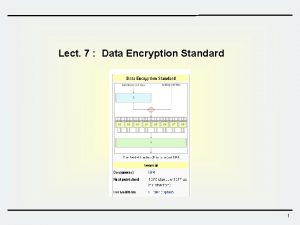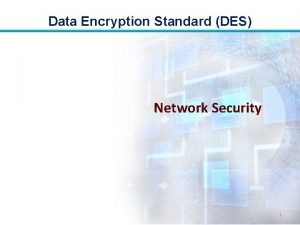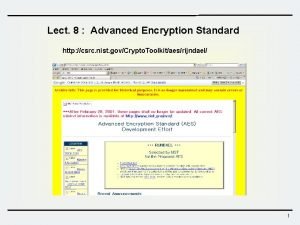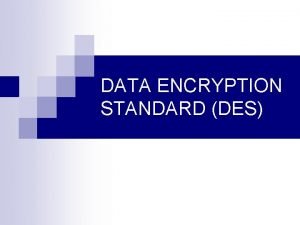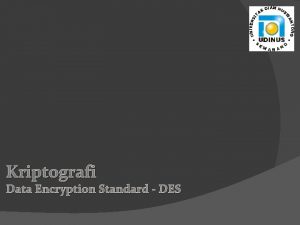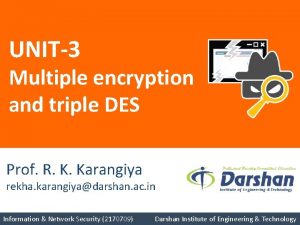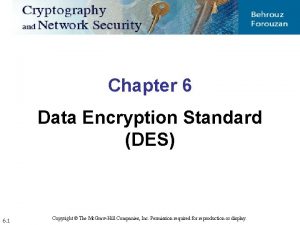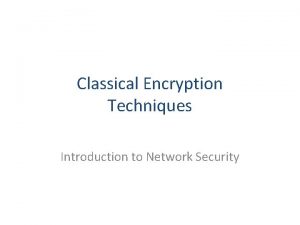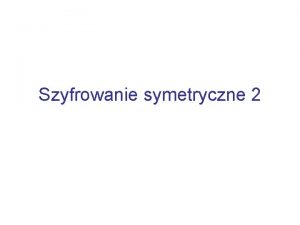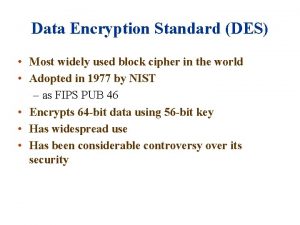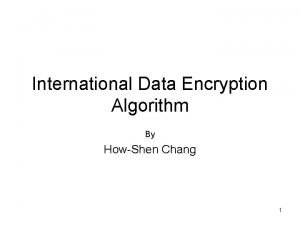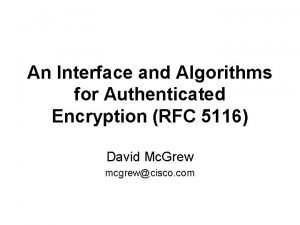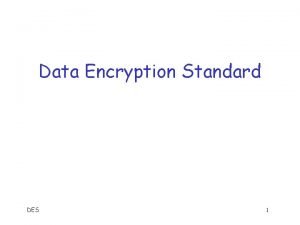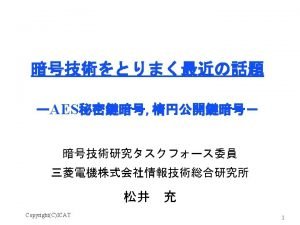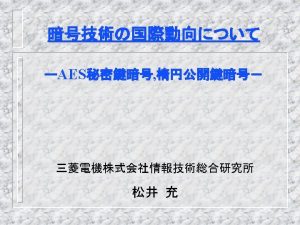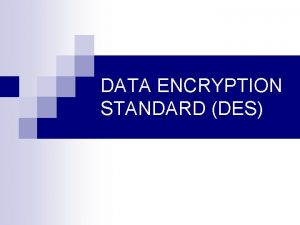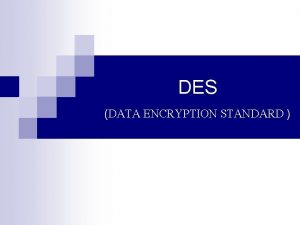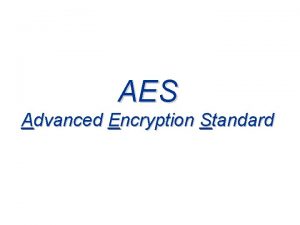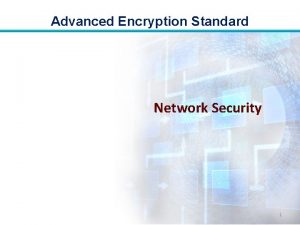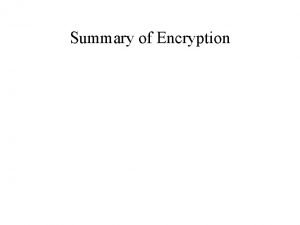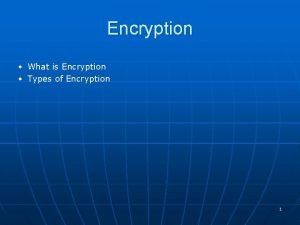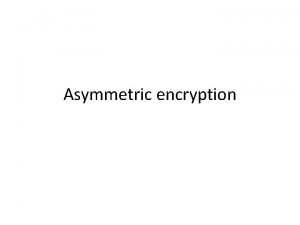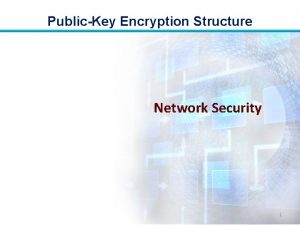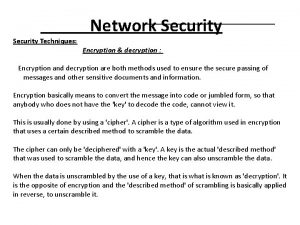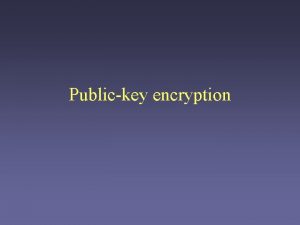DATA ENCRYPTION STANDARD DES Rajdeep Shaktawat Information Security























- Slides: 23

DATA ENCRYPTION STANDARD (DES) Rajdeep Shaktawat – Information Security

DATA ENCRYPTION STANDARD �The Data Encryption Standard (DES) is a symmetric-key block cipher published by the National Institute of Standards and Technology (NIST). �In 1973, NIST published a request for proposals for a national symmetric-key cryptosystem. A proposal from IBM, a modification of a project called Lucifer, was accepted as DES was published in the Federal Register in March 1975 as a draft of the Federal Information Processing Standard (FIPS).

DES – Encryption and Decryption

DES Structure �Des is based on Confusion and Diffusion �The encryption process is made of two permutations (P-boxes), which we call initial and final permutations, and sixteen Feistel rounds. �Every 8 th bit is discarded from 64 bit key which results in 56 bit key.

DES – Structure

Initial and final permutation steps in DES

Initial and final permutation tables

NOTE** � The initial and final permutations are straight P-boxes that are inverses of each other. � They have no cryptography significance in DES.

DES uses 16 rounds. Each round of DES is a Feistel cipher. – IP TEXT in 2

What happen in each round

Ke. Y Transformation � 48 bit sub key is generated in each round from 56 bit key which we have by process KEY TRANSFORMATION � 56 bit key divided in two halves : 28 each � These halves are circularly shifted by one two positions depending on rounds � After shifting 48 bit key from two halves are selected from 56 bit key set � Compression permutation

Expansion Permutation – RPT is expanded from 32 to 48 bits

Before going in S – BOX � The 48 bit RPT out obtained in “ XOR” with 48 bit subkey generated from 56 bit key

S-BOX : The S-boxes do the real mixing (confusion). DES uses 8 S-boxes, each with a 6 -bit input and a 4 -bit output.

S- BOX RULE

Example – S BOX-1 rule

P-BOX permutation – straight replace

XOR and SWAP � LPT was untouched in whole process � RESULT LPT “XOR” RPT (After 1 round process) � For NEXT ROUND � Old RPT becomes now LPT � And RESULT becomes RPT

After 16 such rounds Final Permutation � Refer from Text book � 4 rows 16 coulmns

Double DES

Triple DES

Strength of DES �S box design took years for IBM � 56 -bit keys have 256 = 7. 2 x 1016 values ◦ Brute force search looks hard. ◦ A machine performing one DES encryption per microsecond would take more than a thousand year to break the cipher. � Recent advances have shown is possible ◦ in 1997 on Internet in a few months ◦ in 1998 on dedicated h/w in a few days ◦ in 1999 above combined in 22 hrs!

Meet in the MIDDLE ATTACK � …. .
 Modern block cipher in cryptography
Modern block cipher in cryptography Data encryption standard exercice corrigé
Data encryption standard exercice corrigé Data encryption standard
Data encryption standard Des in information security
Des in information security Csrc nist
Csrc nist Data encryption standard history
Data encryption standard history Rajdeep kaur funeral
Rajdeep kaur funeral Des des des
Des des des Private security
Private security Multiple encryption and triple des
Multiple encryption and triple des Des encryption example
Des encryption example Classical encryption techniques in network security
Classical encryption techniques in network security Homomorphic encryption standard
Homomorphic encryption standard Advanced encryption standard example
Advanced encryption standard example Aes (ang. advanced encryption standard)
Aes (ang. advanced encryption standard) Desmost
Desmost Explain about visa international security mode
Explain about visa international security mode Cnss security model 27 cells example
Cnss security model 27 cells example International data encryption algorithm
International data encryption algorithm Authenticated encryption with associated data (aead)
Authenticated encryption with associated data (aead) La diffusion des idées des lumières
La diffusion des idées des lumières Il existe des personnes qui sont des lumières pour tous
Il existe des personnes qui sont des lumières pour tous Valeur des temps verbaux
Valeur des temps verbaux Affiche guerre froide
Affiche guerre froide


